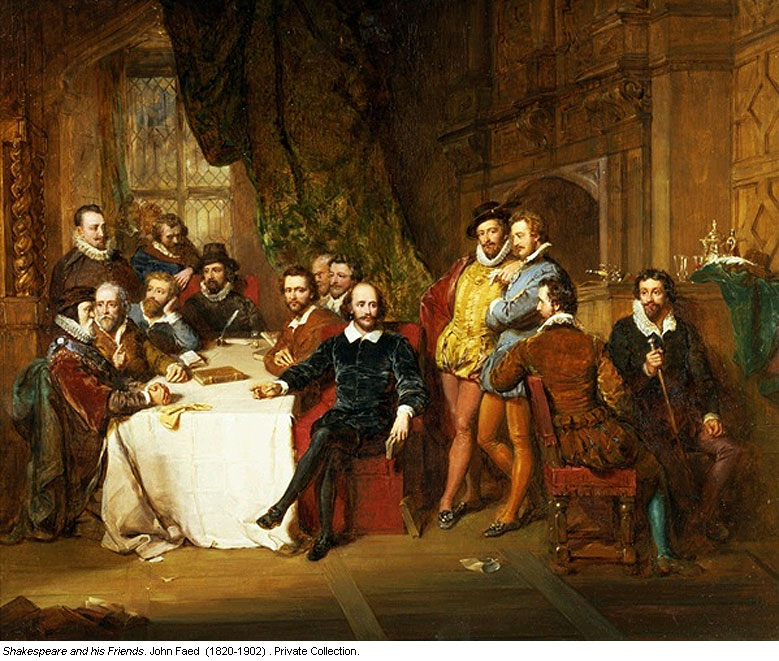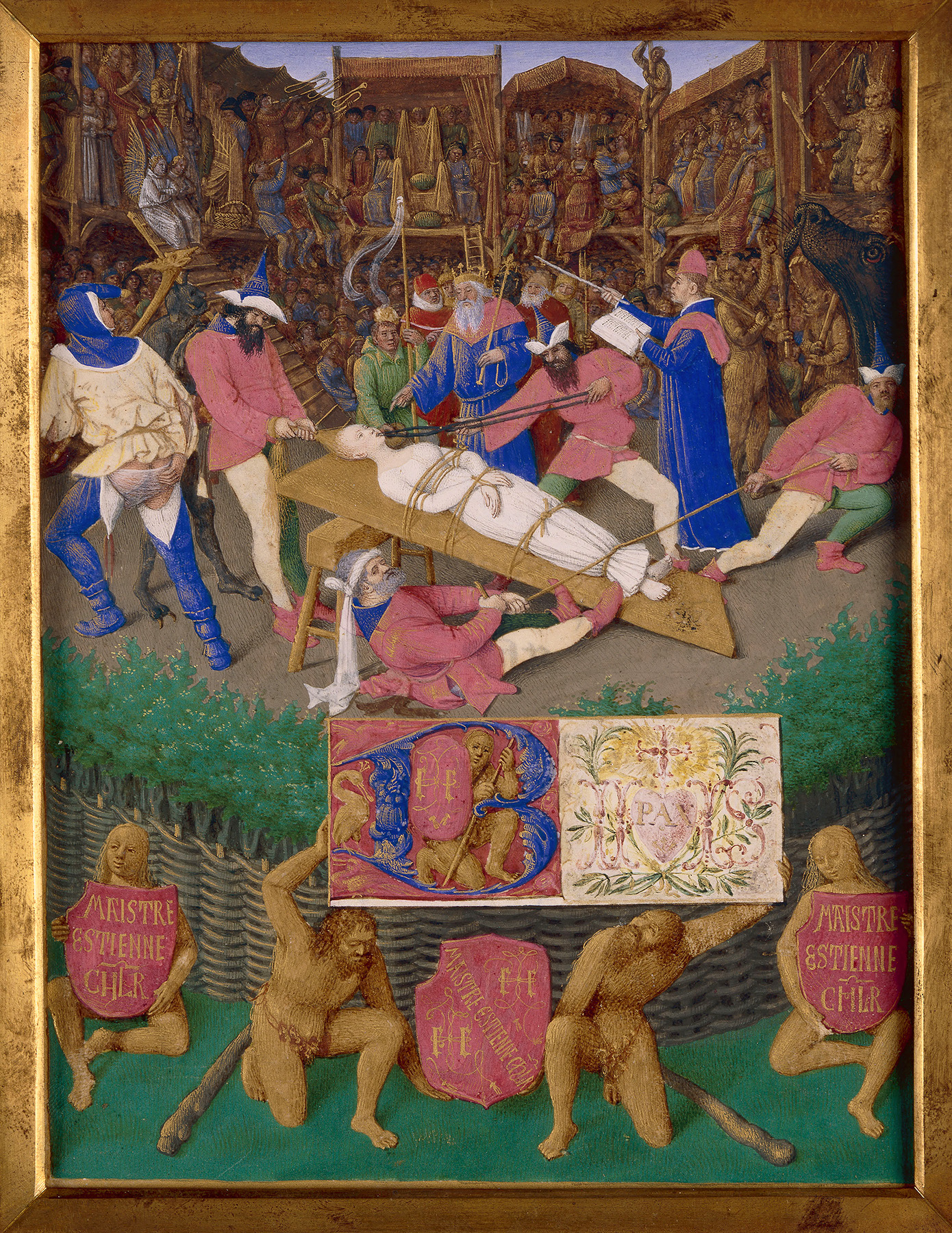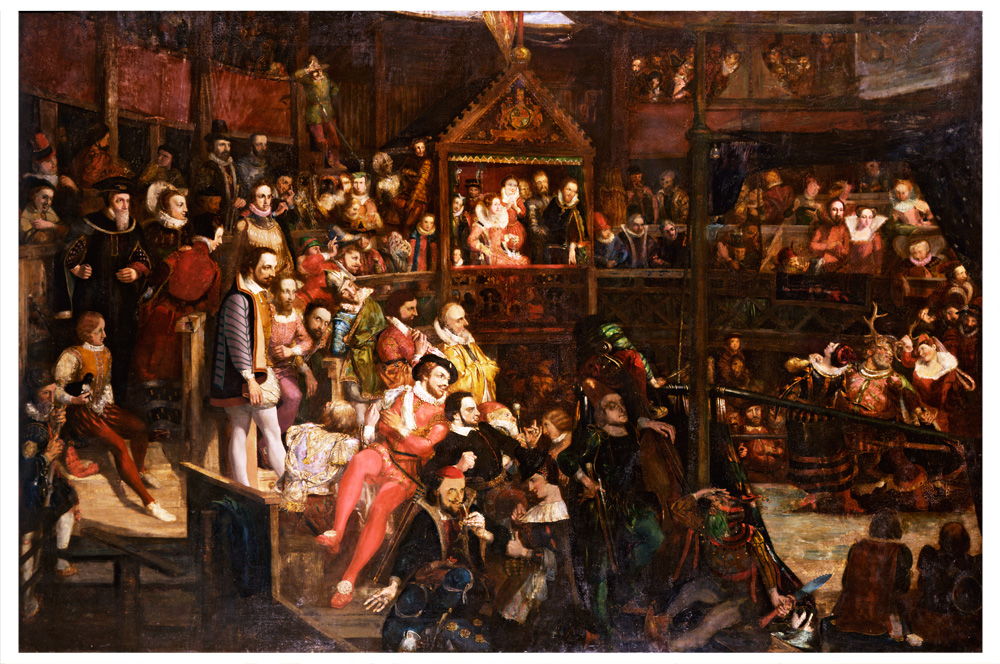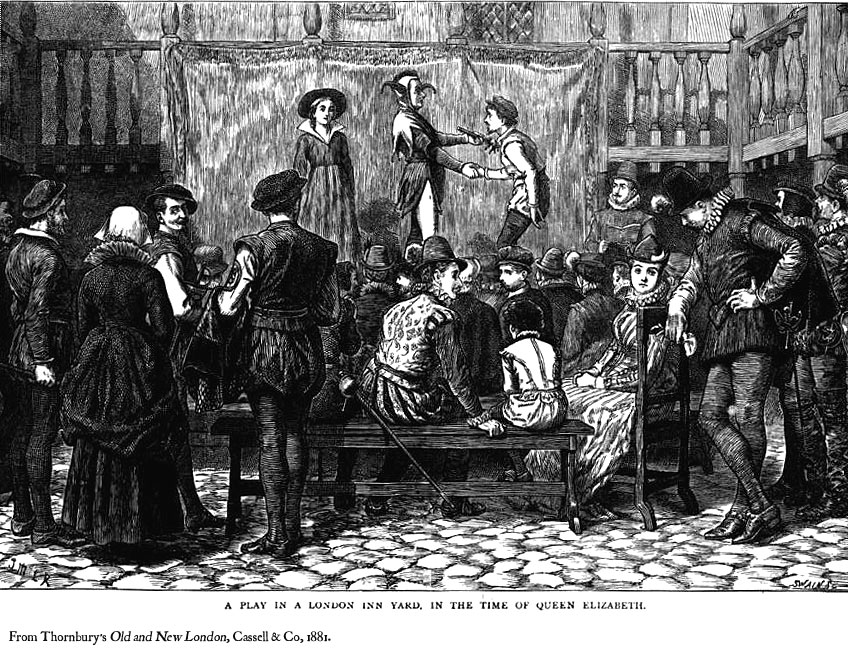English Renaissance theatre, also known as early modern English theatre, or (commonly) as Elizabethan theatre, refers to the theatre of England between 1562 and 1642.
This is the style of the plays of William Shakespeare, Christopher Marlowe and Ben Jonson.
Background
ENGLISH RENAISSANCE THEATRE - English Renaissance theatre, also known as early modern English theatre, or (improperly) as Elizabethan theatre, refers to the theatre of England between 1562 ...
English Renaissance theatre encompasses the period between 1562 (performance at the Inner Temple during the Christmas season of 1561 of Gorboduc, the first English play using blank verse) and 1642 (ban on theatrical plays enacted by the English Parliament).
The phrase Elizabethan theatre is used at times improperly, especially in languages other than English, to mean English Renaissance theatre, even though in a strict sense this only applies to 1603. Strictly speaking one distinguishes within English Renaissance theatre between Elizabethan theatre from 1562 to 1603, Jacobean theatre from 1603 to 1625 and Caroline theatre from 1625 to 1642
Along with the economics of the profession, the character of the drama changed towards the end of the period. Under Elizabeth, the drama was a unified expression as far as social class was concerned: the Court watched the same plays the commoners saw in the public playhouses. With the development of the private theatres, drama became more oriented towards the tastes and values of an upper-class audience. By the later part of the reign of Charles I, few new plays were being written for the public theatres, which sustained themselves on the accumulated works of the previous decades.
Theatrical life and the establishment of permanent theatres

Theatrical life was largely centred just outside of London, as the theatre was banned inside the city itself, but plays were performed by touring companies all over England.
English companies even toured and performed English plays abroad, e.g. in Germany and in Denmark.
The period starts before the establishment of the first permanent theatres. Initially two types of location were used for performing plays, the courtyards of inns and the Inns of Court such as the Inner Temple. These venues continued to be used even after permanent theatres were established.
The first permanent English theatre, the 'Red Lion' opened in 1567 but it was a short-lived failure. The first successful theatres, such as The Theatre, opened in 1576.
The establishment of large and profitable public theatres was an essential enabling factor in the success of English Renaissance drama. Once they were in operation, drama could become a fixed and permanent rather than a transitory phenomenon. Their construction was prompted when the Mayor and Corporation of London first banned plays in 1572 as a measure against the plague, and then formally expelled all players from the city in 1575. This prompted the construction of permanent playhouses outside the jurisdiction of London, in the liberties of Halliwell/Holywell in Shoreditch and later the Clink, and at Newington Butts near the established entertainment district of St. George's Fields in rural Surrey. The Theatre was constructed in Shoreditch in 1576 by James Burbage with his brother-in-law John Brayne (the owner of the unsuccessful Red Lion playhouse of 1567) and the Newington Butts playhouse was set up, probably by Jerome Savage, some time between 1575 and 1577. The Theatre was rapidly followed by the nearby Curtain Theatre (1577), the Rose (1587), the Swan (1595), the Globe (1599), the Fortune (1600), and the Red Bull (1604).
Archaeological excavations on the foundations of the Rose and the Globe in the late 20th century showed that all the London theatres had individual differences; yet their common function necessitated a similar general plan. The public theatres were three stories high, and built around an open space at the centre. Usually polygonal in plan to give an overall rounded effect (though the Red Bull and the first Fortune were square), the three levels of inward-facing galleries overlooked the open centre, into which jutted the stageâ€"essentially a platform surrounded on three sides by the audience, only the rear being restricted for the entrances and exits of the actors and seating for the musicians. The upper level behind the stage could be used as a balcony, as in Romeo and Juliet or Antony and Cleopatra, or as a position from which an actor could harangue a crowd, as in Julius Caesar.
The playhouses were generally built with timber and plaster, and were three stories high. Individual theatre descriptions give additional information to their construction, such as flint stones being used to build the Swan. Theatres were also constructed to be able to hold large amounts of people.
A different model was developed with the Blackfriars Theatre, which came into regular use on a long-term basis in 1599. The Blackfriars was small in comparison to the earlier theatres and roofed rather than open to the sky; it resembled a modern theatre in ways that its predecessors did not. Other small enclosed theatres followed, notably the Whitefriars (1608) and the Cockpit (1617). With the building of the Salisbury Court Theatre in 1629 near the site of the defunct Whitefriars, the London audience had six theatres to choose from: three surviving large open-air "public" theatres, the Globe, the Fortune, and the Red Bull, and three smaller enclosed "private" theatres, the Blackfriars, the Cockpit, and the Salisbury Court. Audiences of the 1630s benefited from a half-century of vigorous dramaturgical development; the plays of Marlowe and Shakespeare and their contemporaries were still being performed on a regular basis (mostly at the public theatres), while the newest works of the newest playwrights were abundant as well (mainly at the private theatres).
Around 1580, when both the Theatre and the Curtain were full on summer days, the total theatre capacity of London was about 5000 spectators. With the building of new theatre facilities and the formation of new companies, the capital's total theatre capacity exceeded 10,000 after 1610.
Ticket prices in general varied during this time period. The cost of admission was based on where in the theatre a person wished to be situated, or based on what a person could afford. If people wanted a better view of the stage or to be more separate from the crowd, they would pay more for their entrance. Due to inflation that occurred during this time period, admission increased in some theatres from a penny to a sixpence or even higher.
Performances

The acting companies functioned on a repertory system; unlike modern productions that can run for months or years on end, the troupes of this era rarely acted the same play two days in a row. Thomas Middleton's A Game at Chess ran for nine straight performances in August 1624 before it was closed by the authoritiesâ€"but this was due to the political content of the play and was a unique, unprecedented, and unrepeatable phenomenon. Consider the 1592 season of Lord Strange's Men at the Rose Theatre as far more representative: between 19 Feb. and 23 June the company played six days a week, minus Good Friday and two other days. They performed 23 different plays, some only once, and their most popular play of the season, The First Part of Hieronimo, (based on Kyd's The Spanish Tragedy), 15 times. They never played the same play two days in a row, and rarely the same play twice in a week. The workload on the actors, especially the leading performers like Edward Alleyn, must have been tremendous.
One distinctive feature of the companies was that they included only males. Female parts were played by adolescent boy players in women's costume. Performances also occurred in the afternoon since no artificial lighting existed. When the light did begin to fade, candles were lit so that the play could continue until its end. Plays contained little to no scenery as the scenery was described by the actors through the course of the play.
Costumes

Costumes during this time period were often bright in color, visually entrancing, and expensive. Due to the fast-paced nature of the plays and their runs, there was sometimes not even enough time to create period specific costumes for the actors. As a result, the actors wore contemporary and not period specific clothing for the plays. Occasionally costumes were donated to actors by patrons, but more often than not, actors wore the clothes of their day.
Costumes were also used to recognize characters. Colors symbolized class, and costumes were made to reflect that. For example, if a character was royalty, their costume included purple. The colors as well as the different fabrics of the costumes allowed viewers to know the roles of each actor when they came on stage. Even though the English Sumptuary Law of 1574, a law which clearly defined the color, style, and fabric of the clothing different castes could wear, was in effect, a clause was built in that allowed actors to dress in clothes that were above their rank so long as they belonged to a licensed acting troupe.
Playwrights

The growing population of London, the growing wealth of its people, and their fondness for spectacle produced a dramatic literature of remarkable variety, quality, and extent. Although most of the plays written for the Elizabethan stage have been lost, over 600 remain.
The men (no women were professional dramatists in this era) who wrote these plays were primarily self-made men from modest backgrounds. Some of them were educated at either Oxford or Cambridge, but many were not. Although William Shakespeare and Ben Jonson were actors, the majority do not seem to have been performers, and no major author who came on to the scene after 1600 is known to have supplemented his income by acting.
Not all of the playwrights fit modern images of poets or intellectuals. Christopher Marlowe was killed in an apparent tavern brawl, while Ben Jonson killed an actor in a duel. Several probably were soldiers.
Playwrights were normally paid in increments during the writing process, and if their play was accepted, they would also receive the proceeds from one day's performance. However, they had no ownership of the plays they wrote. Once a play was sold to a company, the company owned it, and the playwright had no control over casting, performance, revision or publication.
The profession of dramatist was challenging and far from lucrative. Entries in Philip Henslowe's Diary show that in the years around 1600 Henslowe paid as little as £6 or £7 per play. This was probably at the low end of the range, though even the best writers could not demand too much more. A playwright, working alone, could generally produce two plays a year at most; in the 1630s Richard Brome signed a contract with the Salisbury Court Theatre to supply three plays a year, but found himself unable to meet the workload. Shakespeare produced fewer than 40 solo plays in a career that spanned more than two decades; he was financially successful because he was an actor and, most importantly, a shareholder in the company for which he acted and in the theatres they used. Ben Jonson achieved success as a purveyor of Court masques, and was talented at playing the patronage game that was an important part of the social and economic life of the era. Those who were playwrights pure and simple fared far less well; the biographies of early figures like George Peele and Robert Greene, and later ones like Brome and Philip Massinger, are marked by financial uncertainty, struggle, and poverty.
Playwrights dealt with the natural limitation on their productivity by combining into teams of two, three, four, and even five to generate play texts; the majority of plays written in this era were collaborations, and the solo artists who generally eschewed collaborative efforts, like Jonson and Shakespeare, were the exceptions to the rule. Dividing the work, of course, meant dividing the income; but the arrangement seems to have functioned well enough to have made it worthwhile. (The truism that says, diversify your investments, may have worked for the Elizabethan play market as for the modern stock market.) Of the 70-plus known works in the canon of Thomas Dekker, roughly 50 are collaborations; in a single year, 1598, Dekker worked on 16 collaborations for impresario Philip Henslowe, and earned £30, or a little under 12 shillings per weekâ€"roughly twice as much as the average artisan's income of 1s. per day. At the end of his career, Thomas Heywood would famously claim to have had "an entire hand, or at least a main finger" in the authorship of some 220 plays. A solo artist usually needed months to write a play (though Jonson is said to have done Volpone in five weeks); Henslowe's Diary indicates that a team of four or five writers could produce a play in as little as two weeks. Admittedly, though, the Diary also shows that teams of Henslowe's house dramatistsâ€"Anthony Munday, Robert Wilson, Richard Hathwaye, Henry Chettle, and the others, even including a young John Websterâ€"could start a project, and accept advances on it, yet fail to produce anything stageworthy. (Modern understanding of collaboration in this era is biased by the fact that the failures have generally disappeared with barely a trace; for one exception to this rule, see: Sir Thomas More.). Most playwrights, like Shakespeare for example, wrote in verse.
Timeline
Short yellow lines indicate 27 years â€" the average age these authors began their playwrighting careers.
Genres
Genres of the period included the history play, which depicted English or European history. Shakespeare's plays about the lives of kings, such as Richard III and Henry V, belong to this category, as do Christopher Marlowe's Edward II and George Peele's Famous Chronicle of King Edward the First. History plays dealt with more recent events, like A Larum for London which dramatizes the sack of Antwerp in 1576.
Tragedy was an amazingly popular genre. Marlowe's tragedies were exceptionally popular, such as Dr. Faustus and The Jew of Malta. The audiences particularly liked revenge dramas, such as Thomas Kyd's The Spanish Tragedy. The four tragedies considered to be Shakespeare's greatest (Hamlet, Othello, King Lear, and Macbeth) were composed during this period, as well as many others (see Shakespearean tragedy).
Comedies were common, too. A subgenre developed in this period was the city comedy, which deals satirically with life in London after the fashion of Roman New Comedy. Examples are Thomas Dekker's The Shoemaker's Holiday and Thomas Middleton's A Chaste Maid in Cheapside.
Though marginalised, the older genres like pastoral (The Faithful Shepherdess, 1608), and even the morality play (Four Plays in One, ca. 1608-13) could exert influences. After about 1610, the new hybrid subgenre of the tragicomedy enjoyed an efflorescence, as did the masque throughout the reigns of the first two Stuart kings, James I and Charles I.
Printed texts
Only a minority of the plays of English Renaissance theatre were ever printed; of Heywood's 220 plays noted above, only about 20 were published in book form. A little over 600 plays were published in the period as a whole, most commonly in individual quarto editions. (Larger collected editions, like those of Shakespeare's, Ben Jonson's, and Beaumont and Fletcher's plays, were a late and limited development.) Through much of the modern era, it was thought that play texts were popular items among Renaissance readers that provided healthy profits for the stationers who printed and sold them. By the turn of the 21st century, the climate of scholarly opinion shifted somewhat on this belief: some contemporary researchers argue that publishing plays was a risky and marginal businessâ€"though this conclusion has been disputed by others. Some of the most successful publishers of the English Renaissance, like William Ponsonby or Edward Blount, rarely published plays.
A small number of plays from the era survived not in printed texts but in manuscript form.
End of English Renaissance theatre: ban on plays by the English Parliament
The rising Puritan movement was hostile toward theatre, as they felt that "entertainment" was sinful. Politically, playwrights and actors were clients of the monarchy and aristocracy, and most supported the Royalist cause. The Puritan faction, long powerful in London, gained control of the city early in the First English Civil War, and on 2 September 1642, the Parliament, pushed by the Parliamentarian party, under Puritan influence, banned the staging of plays in the London theatres though it did not, contrary to what is commonly stated, order the closure, let alone the destruction, of the theatres themselves:
The text of the act is as follows: Whereas the distressed Estate of Ireland, steeped in her own Blood, and the distracted Estate of England, threatened with a Cloud of Blood by a Civil War, call for all possible Means to appease and avert the Wrath of God, appearing in these Judgements; among which, Fasting and Prayer, having been often tried to be very effectual, having been lately and are still enjoined; and whereas Public Sports do not well agree with Public Calamities, nor Public Stage-plays with the Seasons of Humiliation, this being an Exercise of sad and pious Solemnity, and the other being Spectacles of Pleasure, too commonly expressing lascivious Mirth and Levity: It is therefore thought fit, and Ordained, by the Lords and Commons in this Parliament assembled, That, while these sad causes and set Times of Humiliation do continue, Public Stage Plays shall cease, and be forborn, instead of which are recommended to the People of this Land the profitable and seasonable considerations of Repentance, Reconciliation, and Peace with God, which probably may produce outward Peace and Prosperity, and bring again Times of Joy and Gladness to these Nations.
Note that the Act purports the ban to be temporary ("...while these sad causes and set Times of Humiliation do continue, Public Stage Plays shall cease and be forborn") but does not assign a time limit to it.
After 1642, during the English Civil War and the ensuing Interregnum (English Commonwealth), even after the Puritan mandated banning of the performance of plays, theatrical activity which continued English Renaissance theatre could be seen to some extent, e.g. in the form of short comical plays called Drolls that were allowed by the authorities, while proper full-length plays were banned. The theatres were not closed. The buildings were used for purposes other than staging plays.
The performance of plays remained banned for most of the next eighteen years, becoming allowed again after the Restoration of the monarchy in 1660. The theatres started again performing many of the plays of the previous era, though often in adapted forms; new genres of Restoration comedy and spectacle soon evolved, giving English theatre of the later seventeenth century its distinctive character.
List of playwrights (some of these are actors, not playwrights)
Playhouses
Playing companies
This timeline charts the existence of major English playing companies from 1572 ("Acte for the punishment of Vacabondes", which legally restricted acting to players with a patron of sufficient degree) to 1642 (the closing of the theatres by Parliament). A variety of strolling players, and even early London-based troupes existed before 1572. The situations were often fluid, and much of this history is obscure; this timeline necessarily implies more precision than exists in some cases. The labels down the left indicate the most common names for the companies. The bar segments indicate the specific patron. In the case of children's companies (a distinct legal situation) some founders are noted.
Significant others
- Susan Baskervile, investor and litigant
- William Beeston, manager
- George Buc, Master of the Revels 1609â€"1622
- Cuthbert Burbage, entrepreneur
- James Burbage, entrepreneur
- Ralph Crane, scribe
- Philip Henslowe, entrepreneur
- Henry Herbert, Master of the Revels 1623â€"1673
- Edward Knight, prompter
- Francis Langley, entrepreneur
- John Rhodes, manager
- Edmund Tilney, Master of the Revels 1579â€"1609
See also
- Accession Day tilt
- History of theatre
Notes
References
- Chambers, E. K. The Elizabethan Stage. 4 Volumes, Oxford, Clarendon Press, 1923.
- Gurr, Andrew. The Shakespearean Stage 1574â€"1642. Third edition, Cambridge, Cambridge University Press, 1992.
- Halliday, F. E. A Shakespeare Companion 1564â€"1964. Baltimore, Penguin, 1964.
- Keenan, Siobhan.Travelling Players in Shakespeare's England. Basingstoke: Palgrave Macmillan, 2002.
- Dawson, Anthony B. (2002). "International Shakespeare". In Wells, Stanley; Stanton, Sarah. The Cambridge Companion to Shakespeare on Stage. Cambridge: Cambridge University Press. pp. 174â€"193. ISBN 978-0-521-79711-5.
- Keenan, Siobhan. Acting Companies and Their Plays in Shakespeare's London (London: Arden, 2014).
External links
- Early Modern Drama database
- Shakespeare and the Globe from Encyclopædia Britannica; a more comprehensive resource on the theatre of this period than its name suggests.
- A Lecture on Elizabethan Theatre by Thomas Larque
- A site discussing the influence of Ancient Rome on English Renaissance Theatre
- Richard Southern archive at the University of Bristol Theatre Collection, University of Bristol
- Roy, Pinaki. "All the World's a Stage: Remembering the Prominent Renaissance London Playhouses". Yearly Shakespeare (ISSN 0976-9536), Vol. XI, April 2013: 24-32.
- The Francis Longe Collection at the Library of Congress contains some early editions of theatrical works published in English between 1607 and 1812.
